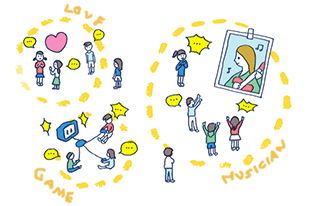to translate "musical essay/theories" to
japanese is quite tough because we japanese are not familiar with a certain word in musical field.
in this topic, i'd like to memo the kind of words and their meanings that are hard to express in our mother tangue.
「音楽のエッセイや理論」を日本語訳するのは少々てこずります。
音楽の世界の単語に余り慣れていないからですが。
このトピックではそういった単語と意味をメモ程度に記したいと思います。
japanese is quite tough because we japanese are not familiar with a certain word in musical field.
in this topic, i'd like to memo the kind of words and their meanings that are hard to express in our mother tangue.
「音楽のエッセイや理論」を日本語訳するのは少々てこずります。
音楽の世界の単語に余り慣れていないからですが。
このトピックではそういった単語と意味をメモ程度に記したいと思います。
|
|
|
|
コメント(2)
Hi ! Thank you.
It might be a good idea to translate my seven basic rules. This will definitely be part of the book...
THE SEVEN BASIC RULES FOR PINPOINTING CHORD TONES
NOTE: these are just the rules on which this book is based. The book will have activities for you to learn then forget them. Miles Davis said that the secret of learning Jazz is to master all the theory and then FORGET IT and go out and play. After working through this book you will understand why he said that. Actually I can give away the secret now : The purpose of these rules are to give you a better ability to be able to FIND, USE and HEAR them by being able to UNDERSTAND them. As an example if you see a player playing a really cool chord but don't understand it, you can use these rules to figure out what's happening! In addition, many players often make the mistake of only learning "chords" or "scales" without understanding the purpose of their tones, but then when the chord doesn't fit they don't know what to do. The rules can also help you to better understand the purpose of the the tones so you will know how you can fix chords when they're not working. Once you can do this there will be another bonus: you will no longer have to worry about being confined to a list of possible scales and chords you can use in your solos - - you will actually be able to make you own. All a "scale" or "chord choice" is the PROPER third (and usually the seventh.) Substitute chords and scales consist of those two tones, plus the way you decide to use or alter all the others - - that's all they are ! ! ! Of course, all of this will be further explained in the book. A summary of our basic tonal system below:
1. The root is the tone the chord is usually named after. It is usually played by the bass player. It is usually not necessary in most chord voicings (especially on the bottom, and especially if there is a bass player.)
Most common alteration: Sometimes substituted by the fifth or even the tri-tone, especially by the bass player.
2. Thirds give the chord its "harmonic identity"*. They are very important. (*Unless the chord is suspended.)
Easiest way to find: count up 4 half steps (two whole steps) from the root for a MAJOR type third, 3 half steps (a step and a half) for a MINOR type chord.
most common alteration: Defines the chord. Can not be altered. If you change the third, it loses its identity. BE CAREFUL NOT TO MESS UP YOUR THIRDS !
3. Sevenths are said to give a chord "harmonic stability", so they are important (although there are chords where the seventh is left out).
Finding it: look a half step below the root if the chord is major. If the chord is minor or dominant look 2 half steps (a whole step) below the root. (note: There is also a type of minor chord with a major seventh.)
most common alteration : raised a half step in a minor chord, but usually can't be altered since it helps give the chord its identity. BE CAREFUL !
ex. C-7 (C) Bb Eb; C7 (C) Bb E; Cmajor (C) B E
4. Fifths
calling card: a very neutral tone. Bass players use them a lot, can be used to create pedal points. Potent when flattened (in the right situation.)
Finding it: count up 7 half steps from the root (3 and a half whole steps).
most common alteration: Fifths are often "diminished", meaning in some chords they are lowered a half step.
Some "modern" pianists like to avoid them in chord voicings, others like myself LOVE them.
ex. C-7 (C) Bb Eb G C-7b5 (C) Bb Eb Gb
bass line : C G C Gb | F C F B
5. Ninths
calling card : They fall very naturally in block chords and "3 7" shape chords.
finding them: just a whole step above the root.
most common alterations: sharp or flattened, especially in dominant chords !
ex. Cmajor 9 (C) E G B D, C9 (C) E Bb D
6. Thirteenths (a.k.a. the sixth).
calling card: Indespensible in gosple. If you find yourself playing a fifth, often playing the thirteenth instead will give a more open sound. According to its alteration can be used to adjust tension level of the chord.
Finding them: Look a whole step above the fifth, or count down a minor third (three half steps, step and half) below the root.
most common alteration: flattened in minor and dominant chords.
example: C13 (C) Bb E A C7b13(alt) (C) Bb E Ab
7. The Fourth
calling card: What modern Jazz is all about. Often replaces the third or fifth in more modernistic tunes, but be careful !
finding it: Count 5 half steps up from the root (2 and a half whole steps). Its also a whole step below the fifth.
most common alteration: sharpened in major chords for a more modern lydian sound. Also good for ending a tune on...
ex. of its sound: (C) E F# A D
It might be a good idea to translate my seven basic rules. This will definitely be part of the book...
THE SEVEN BASIC RULES FOR PINPOINTING CHORD TONES
NOTE: these are just the rules on which this book is based. The book will have activities for you to learn then forget them. Miles Davis said that the secret of learning Jazz is to master all the theory and then FORGET IT and go out and play. After working through this book you will understand why he said that. Actually I can give away the secret now : The purpose of these rules are to give you a better ability to be able to FIND, USE and HEAR them by being able to UNDERSTAND them. As an example if you see a player playing a really cool chord but don't understand it, you can use these rules to figure out what's happening! In addition, many players often make the mistake of only learning "chords" or "scales" without understanding the purpose of their tones, but then when the chord doesn't fit they don't know what to do. The rules can also help you to better understand the purpose of the the tones so you will know how you can fix chords when they're not working. Once you can do this there will be another bonus: you will no longer have to worry about being confined to a list of possible scales and chords you can use in your solos - - you will actually be able to make you own. All a "scale" or "chord choice" is the PROPER third (and usually the seventh.) Substitute chords and scales consist of those two tones, plus the way you decide to use or alter all the others - - that's all they are ! ! ! Of course, all of this will be further explained in the book. A summary of our basic tonal system below:
1. The root is the tone the chord is usually named after. It is usually played by the bass player. It is usually not necessary in most chord voicings (especially on the bottom, and especially if there is a bass player.)
Most common alteration: Sometimes substituted by the fifth or even the tri-tone, especially by the bass player.
2. Thirds give the chord its "harmonic identity"*. They are very important. (*Unless the chord is suspended.)
Easiest way to find: count up 4 half steps (two whole steps) from the root for a MAJOR type third, 3 half steps (a step and a half) for a MINOR type chord.
most common alteration: Defines the chord. Can not be altered. If you change the third, it loses its identity. BE CAREFUL NOT TO MESS UP YOUR THIRDS !
3. Sevenths are said to give a chord "harmonic stability", so they are important (although there are chords where the seventh is left out).
Finding it: look a half step below the root if the chord is major. If the chord is minor or dominant look 2 half steps (a whole step) below the root. (note: There is also a type of minor chord with a major seventh.)
most common alteration : raised a half step in a minor chord, but usually can't be altered since it helps give the chord its identity. BE CAREFUL !
ex. C-7 (C) Bb Eb; C7 (C) Bb E; Cmajor (C) B E
4. Fifths
calling card: a very neutral tone. Bass players use them a lot, can be used to create pedal points. Potent when flattened (in the right situation.)
Finding it: count up 7 half steps from the root (3 and a half whole steps).
most common alteration: Fifths are often "diminished", meaning in some chords they are lowered a half step.
Some "modern" pianists like to avoid them in chord voicings, others like myself LOVE them.
ex. C-7 (C) Bb Eb G C-7b5 (C) Bb Eb Gb
bass line : C G C Gb | F C F B
5. Ninths
calling card : They fall very naturally in block chords and "3 7" shape chords.
finding them: just a whole step above the root.
most common alterations: sharp or flattened, especially in dominant chords !
ex. Cmajor 9 (C) E G B D, C9 (C) E Bb D
6. Thirteenths (a.k.a. the sixth).
calling card: Indespensible in gosple. If you find yourself playing a fifth, often playing the thirteenth instead will give a more open sound. According to its alteration can be used to adjust tension level of the chord.
Finding them: Look a whole step above the fifth, or count down a minor third (three half steps, step and half) below the root.
most common alteration: flattened in minor and dominant chords.
example: C13 (C) Bb E A C7b13(alt) (C) Bb E Ab
7. The Fourth
calling card: What modern Jazz is all about. Often replaces the third or fifth in more modernistic tunes, but be careful !
finding it: Count 5 half steps up from the root (2 and a half whole steps). Its also a whole step below the fifth.
most common alteration: sharpened in major chords for a more modern lydian sound. Also good for ending a tune on...
ex. of its sound: (C) E F# A D
- mixiユーザー
- ログインしてコメントしよう!
|
|
|
|
Jazz Education (Private) 更新情報
-
最新のイベント
-
まだ何もありません
-
-
最新のアンケート
-
まだ何もありません
-























